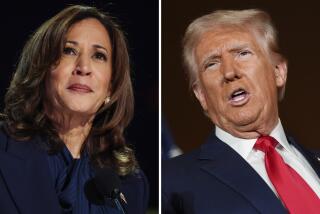Congress Weighs Compromise on Dividend Taxes
WASHINGTON — President Bush’s insistence on a controversial proposal to eliminate taxes on dividends is threatening to squeeze out other, more popular elements of his tax cut plan that would help people in lower-income brackets.
As Republicans scrambled Wednesday to make room for some form of dividend tax relief within the limits of much lower overall tax cut targets set by Congress, they rummaged through alternatives that could scale back measures to boost tax relief for married couples and families with children.
One option being discussed among Senate Republicans would increase the per-child tax credit for only one year -- not permanently, as Bush has proposed. Similar proposals to make family tax relief temporary were being considered by House Republicans, who may unveil their tax cut plan as soon as today.
Those are the kinds of trade-offs the Republicans are confronting as they struggle to pare back Bush’s request for a wide range of tax cuts totaling $725 billion over 11 years to the lower targets set by Congress -- $550 billion in the House and $350 billion in the Senate.
Commerce Secretary Don Evans, after meeting with Senate Republicans on Wednesday, said that Bush remained insistent on eliminating dividend taxes because he believed it was the single most important step Congress could take to revive the stock market and spur economic growth. It is a step that would cost almost $400 billion over 11 years.
“We want to get it to zero,” Evans said of the tax on dividends.
But even in the House, a bastion of Bush loyalists, Republicans say eliminating dividend taxes is unaffordable in a $550-billion tax package. Instead, the plan being crafted by House Ways and Means Chairman Bill Thomas (R-Bakersfield) and backed by GOP leaders is expected to include an alternative that would cut but not eliminate taxes on dividends -- and link it to a cut in capital gains taxes, which Bush did not propose.
Despite uncertainty about the overall size of the tax cut, it seems increasingly likely it will be far less than Bush wants. As a result, key lawmakers have begun discussing which elements can be trimmed or disregarded -- as well as other maneuvers to get around the tax cut ceiling.
Intense controversy over Bush’s plan to eliminate dividend taxes has overshadowed the broad appeal to many lawmakers of other provisions in his tax cut package.
For example, members of both parties support the Bush proposal that would affect more taxpayers than any other element of his plan: an expansion of the 10% tax bracket, the lowest rate. If that provision had been in effect in 2001, it would have benefited 7.8 million taxpayers in California alone, the Treasury Department said.
The elimination of dividend taxes, by comparison, would have helped 3.9 million taxpayers in the state.
The expansion of the 10% tax bracket will be phased in by 2008 under the tax cut law approved in 2001. But Bush’s new plan calls for speeding up this and other tax cuts contained in that law.
That would mean that this year, the 27% rate would drop to 25%, the 30% rate to 28%, the 35% rate to 33% and the top rate of 39.6% rate to 35%. The most controversial component is the top rate: Many Democrats are vehemently opposed to speeding up that reduction.
The Bush plan also would immediately implement tax relief for married couples to reduce the so-called marriage penalty. The 2001 law would not begin providing such relief until 2005, and it would not be fully phased in until 2009.
The 2001 law called for gradually increasing the per-child tax credit from $600 now to $1,000 by 2010. Applying the full increase in 2003 would provide the most benefit to lower income taxpayers, because the credit goes only to those below a certain income level -- $110,000 annually for joint filers.
While the White House pushes for the elimination of the tax on dividends, lawmakers are looking for ways to curb that proposal’s cost so there is enough money left to pay for income tax rate reductions and the family tax-relief provisions.
Sen. John B. Breaux of Louisiana, a moderate Democrat who supports a $350-billion tax cut, has suggested allowing taxpayers to exclude from taxation the first $500 of dividend income.
An idea floated by some Republicans on the Senate Finance Committee would eliminate the dividend tax for two years. That is the proposal that also calls for increasing the child credit to $1,000 in 2003 -- but only for one year.
Aides said that was a cutoff designed to reduce the cost of the tax package; it is assumed that the increased tax credit would be extended every year.
But strong advocates of the family tax credit -- including Sen. Olympia J. Snowe (R-Maine), a key member of the Finance Committee -- are not likely to want to take that risk.
“Just what we need: something to help wealthy Americans at the expense of children and families,” said a Snowe aide. “I don’t think she’ll support it.”
The proposal being floated by Thomas and backed by the House GOP leadership would cut taxes on dividend income, which are now paid at the same rate as ordinary income, probably to 15% for most taxpayers and 5% for lower-income people.
The plan also would bring the tax on capital gains, which is income from the sale of real estate and other assets, in line with the revised dividend tax. That would cut the tax rate on capital gains, which is now 20% for most people and 10% for lower-income people.
More to Read
Get the L.A. Times Politics newsletter
Deeply reported insights into legislation, politics and policy from Sacramento, Washington and beyond. In your inbox three times per week.
You may occasionally receive promotional content from the Los Angeles Times.











